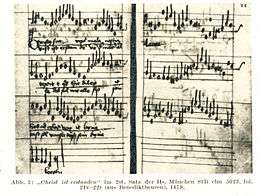Christ ist erstanden
"Christ ist erstanden" (Christ is risen) is a German Easter hymn,[1] and is possibly the oldest Christian liturgical German song. It has inspired music by composers such as Ludwig Senfl and Heinrich Schütz (from the sixteenth and seventeenth centuries respectively) through to modern composers such as Oskar Gottlieb Blarr and Enjott Schneider, and has appeared in 45 hymnals, including the current German Catholic and Protestant hymnals. Translations and paraphrases include a version by Catherine Winkworth which has appeared in 231 hymnals. "Christ ist erstanden" also inspired Martin Luther to write "Christ lag in Todes Banden", deriving the melody from it.
| "Christ ist erstanden" | |
|---|---|
| German Easter hymn | |
 Apel Codex, manuscript from c. 1500 | |
| English | Christ is risen |
| Catalogue | Zahn 8584 |
| Language | German |
| Published | c. 1160 |
History
"Christ ist erstanden" is possibly the oldest liturgical song in German.[2] The first stanza was sung around 1100 to venerate the cross.[2] It is mentioned in 1160 in an order of liturgy of the diocese of Salzburg, which is kept as the Codex MII6 at the library of the University of Salzburg; it is a Leise (a form of medieval church song), each verse ending with the word "Kyrieleis" (from the Greek "kyrie eleison", for "Lord have mercy").[2]

The hymn tune, Zahn No. 8584,[3] is derived from "Victimae paschali laudes", a sequence for Easter, by Wipo of Burgundy. The melody appeared in the Apel Codex, a manuscript from around 1500. From the 14th century, "Victimae paschali laudes" and "Christ ist erstanden" were sung alternatively. From the 15th century, different versions with several stanzas were in print.[2] Martin Luther codified a version in three stanzas in 1529 and 1533 in Klug's hymnal, in which Luther changed the line "So freut sich alles, was da ist" (So everything living is glad), frequently used in older versions, to "So lobn wir den Vater Jesu Christ (So we praise the father of Jesus Christ), with an emphasis on Christology instead of universality.[2] He also wrote his own paraphrase of "Victimae paschali laudes", "Christ lag in Todesbanden", published in 1524.[4] Since then, it has been printed in German-language Protestant hymnals up to Evangelisches Gesangbuch (EG 99). It is also part of the current German-language Catholic hymnal Gotteslob (GL 318, 213 in the 1975 version), without Luther's alteration.[4] The hymn has appeared in 45 hymnals.[5]
Derived hymns
Michael Weisse, a minister of the Bohemian Brethren, wrote a hymn "Christ ist erstanden" in seven stanzas, using the same melody.[6] Catherine Winkworth translated that hymn to "Christ the Lord Is Risen Again!", published in 1858, which has appeared in 231 hymnals.[7]
Text

Christ ist erstanden
von der Marter alle!
Des solln wir alle froh sein,
Christ soll unser Trost sein.
Kyrioleis.
Wär er nicht erstanden,
so wär die Welt vergangen.
Seit daß er erstanden ist,
so freut sich alles, was da ist.[lower-alpha 1]
Kyrioleis.
Alleluja,
alleluja,
alleluja!
Des solln wir alle froh sein,
Christ soll unser Trost sein.
Kyrioleis.
Musical settings

Ludwig Senfl composed a setting for six voices in the 15th century.[1] Heinrich Schütz wrote Christ ist erstanden, a setting for three vocal choirs, a choir of trombones and a choir of viols. Bach used the final stanza of the hymn to conclude his Easter cantata Erfreut euch, ihr Herzen, BWV 66. He also employed the hymn for the chorale prelude BWV 627 of his Orgelbüchlein.[8]
Max Reger set the hymn in 1900 for seven-part choir (SSAATTB) a cappella and included it as No. 8 in his Zwölf deutsche geistliche Gesänge (Twelve German sacred songs), WoO VI/13, named "Ein alt' Lob- und Freudenlied von der Urstend unsers lieben Herrn Christi" (An old song of praise and joy of the resurrection of our dear Lord Christ).[9] Settings from the 20th century include organ works by Oskar Gottlieb Blarr and Hermann Schroeder.[2] Enjott Schneider composed a setting for four-part choir with optional organ in 2012.[10]
Notes
- Text as in Gotteslob (GL 318), while the Evangelisches Gesangbuch (EG 99) has "so lobn wir den Vater Jesu Christ"
References
- "Chorale Melodies used in Bach's Vocal Works / Christ ist erstanden". bach-cantatas.com. 2011. Retrieved 4 July 2014.
- Fischer, Michael (2007). "Christ ist erstanden". Historisch-Kritisches Liederlexikon des Deutschen Volksliedarchivs (in German). Retrieved 7 April 2017.
- Zahn, Johannes (1892). Die Melodien der deutschen evangelischen Kirchenlieder (in German). V. Gütersloh: Bertelsmann. pp. 260–261.
- Hahn, Gerhard; Henkys, Jürgen, eds. (2004). 99 "Christ ist erstanden". Liederkunde zum Evangelischen Gesangbuch (in German). Vandenhoeck & Ruprecht. pp. 55–60. ISBN 9783525503331.
- "Christ ist erstanden". hymnary.org. Retrieved 4 July 2014.
- "Christus ist erstanden, von des Todes-Banden". hymnary.org. Retrieved 26 April 2017.
- "Christ the Lord is risen again!". hymnary.org. Retrieved 7 April 2017.
- Williams, Peter (2003), The Organ Music of J. S. Bach (2nd ed.), Cambridge University Press, pp. 284–286, ISBN 0-521-89115-9
- "Zwölf deutsche geistliche Gesänge WoO VI/13" (in German). Max-Reger-Institute. 2017. Retrieved 7 April 2017.
- "Christ ist erstanden". Carus-Verlag. Retrieved 4 July 2014.
External links
| Wikimedia Commons has media related to Christ ist erstanden. |
- Christ ist erstanden ChoralWiki
- Christ ist erstanden (in German) Deutsche Digitale Bibliothek
- Christ ist erstanden (in German) Stiftung Preußischer Kulturbesitz